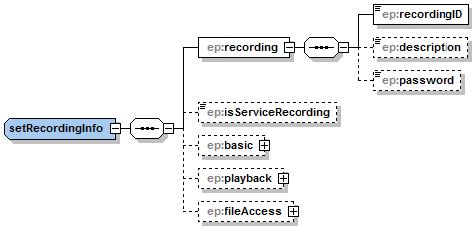SetRecordingInfo
The SetRecordingInfo function allows users to set specific information about a recording. This information includes, but is not limited to the recordingID, description, and password.
Request
The sample XML shows an example of how to set up a recording.
<?xml version="1.0" encoding="UTF-8"?>
<serv:message xmlns:xsi="http://www.w3.org/2001/XMLSchema-instance"
xmlns:serv="http://www.webex.com/schemas/2002/06/service">
<header>
<securityContext>
<webExID>hostid</webExID>
<password>hostpassword</password>
</securityContext>
</header>
<body>
<bodyContent
xsi:type="java:com.webex.service.binding.ep.SetRecordingInfo">
<recording>
<recordingID>972831222</recordingID>
<description>test description</description>
<password>112233</password>
</recording>
<isServiceRecording>true</isServiceRecording>
<basic>
<topic>nbr_update toc_unlist</topic>
<listing>UNLISTED</listing>
<presenter>presenter</presenter>
<email>test@abc.update</email>
<agenda>test agenda testtest agenda testtest agenda test</agenda>
</basic>
<playback>
<chat>true</chat>
<supportQandA>true</supportQandA>
<video>true</video>
<polling>true</polling>
<notes>true</notes>
<fileShare>true</fileShare>
<toc>true</toc>
<attendeeList>true</attendeeList>
<includeNBRcontrols>true</includeNBRcontrols>
<range>PARTIAL</range>
<partialStart>11</partialStart>
<partialEnd>77</partialEnd>
</playback>
<fileAccess>
<endPlayURL>http://test.abc.com.update</endPlayURL>
<registration>true</registration>
<attendeeView>true</attendeeView>
<attendeeDownload>true</attendeeDownload>
</fileAccess>
</bodyContent>
</body>
</serv:message>
The following schema diagram shows the structure of the elements in the setRecordingInfo request message.
Figure 4-32 • Schema diagram for setRecordingInfo
Response
The sample XML shows an example of a successful response.
<?xml version="1.0" encoding="UTF-8"?>
<serv:message xmlns:serv="http://www.webex.com/schemas/2002/06/service"
xmlns:com="http://www.webex.com/schemas/2002/06/common"
xmlns:ep="http://www.webex.com/schemas/2002/06/service/ep"
xmlns:meet="http://www.webex.com/schemas/2002/06/service/meeting">
<serv:header>
<serv:response>
<serv:result>SUCCESS</serv:result>
<serv:gsbStatus>PRIMARY</serv:gsbStatus>
</serv:response>
</serv:header>
<serv:body>
<serv:bodyContent xsi:type="ep:setRecordingInfoResponse"
xmlns:xsi="http://www.w3.org/2001/XMLSchema-instance">
<ep:recordingID>972831222</ep:recordingID>
</serv:bodyContent>
</serv:body>
</serv:message>
The following schema diagram shows the structure of the elements in the setRecordingInfoResponse message.
Figure 4-33 • Schema diagram for setRecordingInfoResponse

